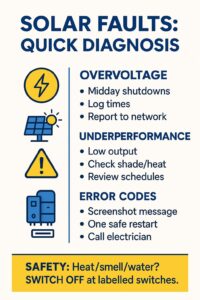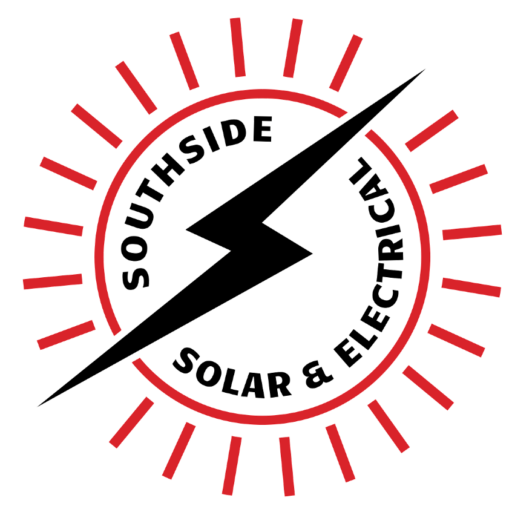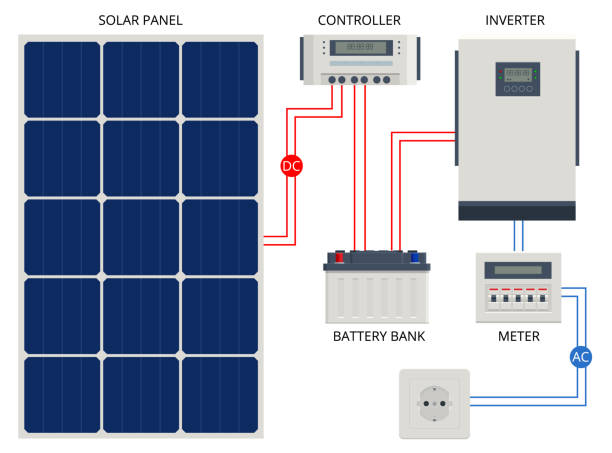This beginner-friendly guide explains the common reasons solar systems stop, slow down, or show error messages. It covers three everyday issues—overvoltage, underperformance, & error codes—and gives simple steps to try before contacting a licensed electrician in Perth.
First: basic safety
- Do not open enclosures or covers. Internal parts hold dangerous voltages even when switched off.
- Use the manufacturer’s on/off procedure only (usually labelled MAIN SWITCH (INVERTER SUPPLY), DC isolators, & battery switch).
- If there is a burning smell, heat discolouration, or tripping breakers, turn the system off using the labelled switches & call a professional.
What the main parts do
- Panels make DC electricity from sunlight.
- Inverter turns that DC into household AC power.
- Battery stores excess energy for night-time or peak tariffs.
- Monitoring app/portal shows status, energy flows & fault messages.
Quick checks anyone can do
- Is the system on?
Look for a screen light or status LED on the inverter/battery. If blank, check the solar/battery switches & the relevant circuit breaker in the switchboard. - Internet/monitoring:
If the app is offline, data & error messages may be missing. Reconnect Wi-Fi/Ethernet so you can see live status. - Time & date:
Wrong time settings can block charging or exporting during the day. Correct the clock in the app if needed. - Shading & cleanliness:
New shade (trees, antennas) or dirty panels reduces output. If safe to view from the ground, check for obvious shade or dirt. Arrange cleaning if heavily soiled. - Recent work on site:
Roof repairs, switchboard work, or re-wiring can disturb solar cabling or metering. Note any recent changes when speaking to an electrician.
Issue 1: Overvoltage (system turns off in the middle of sunny days)
What it looks like: The inverter works in the morning, then repeatedly shuts down around midday on clear days. The app may mention “grid voltage high” or similar.
Why it happens (plain English): When many homes export solar at once, the street voltage can rise. The inverter protects the property by turning itself off until the voltage falls.
What to do next:
- Write down the times it shuts down (e.g., 12:10–13:20).
- Take screenshots of the message in the app.
- Restart once using the maker’s on/off steps (do not keep power-cycling repeatedly).
- If the pattern continues, contact your electricity retailer or network operator and report suspected high voltage at the property. A licensed electrician can also check cable sizes, connections, & settings.
Issue 2: Underperformance (making less energy than expected)
What it looks like: Bills go up, the daily total in the app is lower than usual, or the battery charges more slowly than before—without any clear error message.
Common causes (simple list):
- Shade or dirt on panels; very hot days can also reduce output.
- Mixed panel directions on one input, or a weak panel in a group pulling the others down.
- App schedules, “zero-export” limits, or tariff settings limiting power.
- Loose or weather-affected outdoor switches and connectors.
What to do next:
- Compare a clear, mild day this month with the same season last year in the app.
- Check for new shade (growing trees, new structures).
- Make sure any battery charge/discharge schedules match your tariff & time zone.
- If output stays low, book a health check: an electrician can test strings, thermal-scan hot joints, & confirm settings.
Issue 3: Error codes (what they usually mean)
Every brand uses different wording, but most messages fall into a few groups:
- Grid issue / overvoltage / frequency: Usually a street-supply problem or site voltage rise. Record times & contact the retailer/network if frequent.
- PV voltage out of range / DC error: Panel wiring count or temperature effects need checking; an electrician may re-configure the strings.
- Insulation / ground fault / RCD: Moisture or damaged cable. Turn off using the labelled switches & arrange service.
- Relay/self-test: Internal safety parts or unstable supply. Requires testing by a professional.
- Battery communication / BMS / temperature: Data cable, software, or temperature limits. Check that the battery area is cool & unobstructed; collect screenshots & call for support if it persists.

Battery problems explained simply
- “Battery not charging/empty by evening”:
Check schedules, cheap-rate windows, & time zone. Very hot or cold locations also slow charging. Keep vents clear.
- “Battery percentage stuck at 100% or 0%”:
The gauge can lose its place. Many brands provide a guided “full cycle” to recalibrate—follow the app/manual or ask a technician to assist.
- “Battery drains faster than it used to”:
New appliances, seasonal changes, or settings (e.g., backup reserve too low/high) can explain the change. If unchanged and still worse, book a service check.
- “Noises, swelling, heat, or smell”:
Turn off using the labelled switches & call a licensed electrician immediately.
When to call a professional urgently
- Repeated shutdowns with burning smell or visible damage.
- Water ingress after storms.
- Breakers or safety switches that keep tripping.
- Error codes returning immediately after a single safe restart.
Useful information to collect before a service visit
- Photos of labels (inverter & battery model/serial number).
- Screenshots of the app showing errors & the daily graph.
- Dates/times when the issue occurs.
- Any recent electrical or roofing work at the property.
- Install date & warranty documents if available.
Simple care schedule
- Every 3–6 months: Check the app is online, review daily/weekly graphs, keep the battery area ventilated, & arrange panel cleaning if very dirty.
- Every 12 months: Ask for a routine solar/battery inspection (outdoor switches, connections, settings, firmware).
- After heatwaves/storms: Visual check for loose covers, cracked conduits, or water marks (no opening enclosures).
Conclusion
Diagnosing inverter & battery faults relies on recognising patterns—midday shutdowns that suggest overvoltage, sustained low yield that signals shading or configuration limits, & clear error codes that pinpoint the affected part. Begin with safe checks, record timestamps/screenshots, verify time zones/schedules, & avoid repeated resets to preserve logs. If issues persist, engage a licensed electrician experienced with Solar inverters Perth to confirm grid voltage, string health, metering & communications, then calibrate storage for a dependable solar battery Perth setup that restores performance, protects warranties & minimises downtime.

